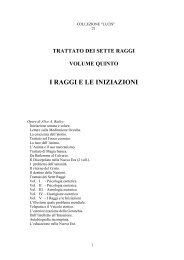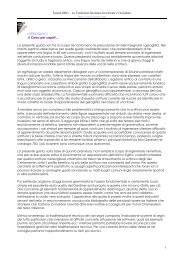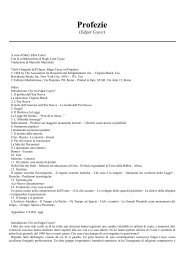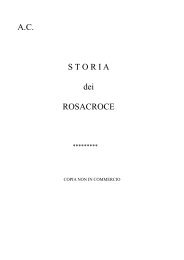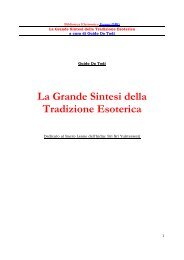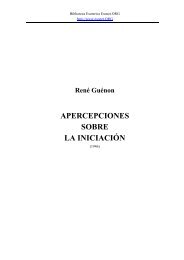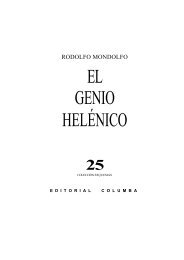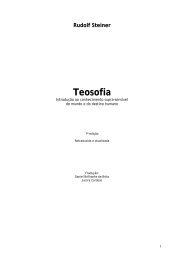Biblioteca Esoterica Esonet.ORG http://www.esonet.ORG 1
Biblioteca Esoterica Esonet.ORG http://www.esonet.ORG 1
Biblioteca Esoterica Esonet.ORG http://www.esonet.ORG 1
You also want an ePaper? Increase the reach of your titles
YUMPU automatically turns print PDFs into web optimized ePapers that Google loves.
<strong>Biblioteca</strong> <strong>Esoterica</strong> <strong>Esonet</strong>.<strong>ORG</strong><br />
<strong>http</strong>://<strong>www</strong>.<strong>esonet</strong>.<strong>ORG</strong><br />
The Principle of Holarchy and<br />
the Interplay of Horizontal and Vertical Relationships - 2<br />
Holism and a hierarchy of levels<br />
The official trend in modern science is still mainly atomistic and focuses considerable<br />
attention on horizontal relationships — a focusing which is even more dominant in<br />
sociology, politics, and popular psychology. The new trend toward the holistic approach<br />
offers a logical basis on which a more inclusive concept of vertical relationships can<br />
develop. A passage from the book Accent on Form by L. L. Whyte, a British philosopher of<br />
science, may be worth quoting here, because it provides apt characterizations of these two<br />
approaches. According to Whyte, the "Atomistic School" of knowledge has been<br />
represented in the European past by "Leucippus, Democritus, Gassendi, Newton, Boyle,<br />
Dalton and contemporary atomic physicists" (his book was written in 1953); among the<br />
leaders of the "Holistic School" he lists "Goethe, Bergson, the Gestalt psychiatrists,<br />
Whitehead, and Jan Smuts." 39<br />
The classical atomistic doctrine asserts that the universe is made up of ultimate particles,<br />
each of which is simple, indivisible, and permanent. All observable changes are due to the<br />
reversible spatial rearrangements of these particles resulting from their motions and<br />
mutual influences. The particles although small must be of a finite size or effectively<br />
occupy a definite volume of space, since a finite number of them make up ordinary<br />
objects. Moreover if atomism is to work there must be very few different kinds of ultimate<br />
particles, for the aim is to simplify our view of nature. The complexity of observed<br />
phenomena is to be accounted for as the result of the motion of units which are each<br />
simple and permanent. This program had the great advantage that it gave physical<br />
measurement and mathematic reasoning something to grip. . .<br />
The holistic view . . .regards the universe as a great hierarchy of unities, each following<br />
its own path of historical development. Each pattern, whether it is a crystal, an organism, a<br />
community, the solar system, or a spiral nebula, possesses its own internal order and is<br />
part of a more extensive order, so that the universe is recognized as a System of systems, a<br />
Grand Pattern of patterns. Every whole with all its parts is subject to developmental<br />
changes which cannot be adequately represented as the mere reversible motions of<br />
independent particles. 40<br />
These two schools of thought are not mutually exclusive; Whyte foresaw their<br />
harmonization in a "School of Elegant Structure combining an intuition of the whole with<br />
the analytical recognition of detail." Since the late 1960s, an important group of<br />
philosophers of science, including Ludwig von Bertalanffy and Erwin Laszlo, has indeed<br />
been developing a "general system theory" and a "systems philosophy" in which what I<br />
call a "whole of being" is more generally and abstractly referred to as a "system." The two<br />
39 Jan Smuts, the South African philosopher-statesman prominent during the formulation of the League of<br />
Nations at the end of World War I, wrote in 1926 a seminal book, Holism and Evolution, which provides a<br />
new interpretation of evolution in the broadest sense of the term. It was Smuts who coined the words holism<br />
and holistic; the popular use of the latter may or may not always be justified.<br />
40 Accent on Form by L. L. Whyte (New York, 1954) pp. 53f<br />
132



